
Are you looking for information on the African Grey Guide? Would you like to know more about this very special animal? Are you considering adopting one and would like to know everything about its habits and needs?
Stop looking around, you’re in the right place! We have helped thousands of people adopt a parrot in the best possible way.
After much research, we have gathered in this guide as much information as possible about this magnificent tropical bird. We also answer the 44 most frequently asked questions about it.
After reading this article, you will therefore know everything about this incredible bird.
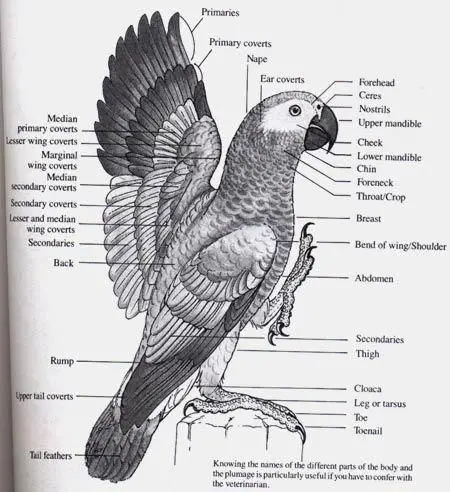
African Grey Parrot
- Latin name: Psittacus erithacus
- Zone: Equatorial Africa (Ghana, Gabon, Kenya, Uganda, Angola, Cameroon, Congo and Côte d’Ivoire
- State of the wild population: Endangered
- Size: 30 – 35 cm (height)
- Weight: 360 – 530 grams
- Wingspan: 45 – 50 cm
- Diet: Fruits, nuts, seeds, flowers, small insects
- Physical characteristics: Gray body with yellow eyes and a red tail
African Parrot Complete Guide
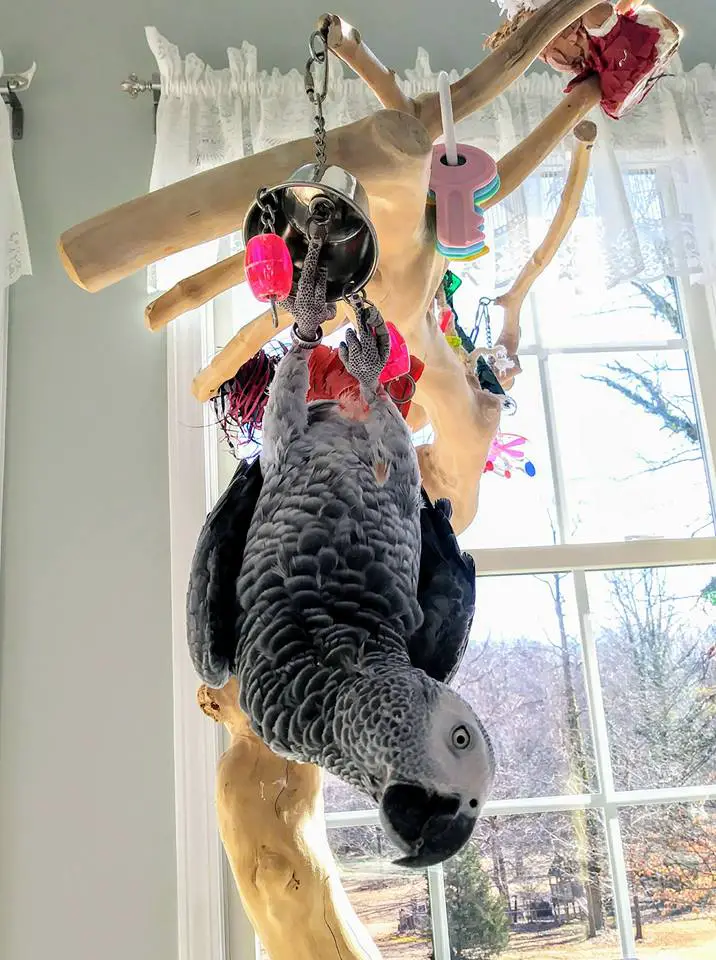
Presentation of African Grey
The African Gray Parrot’s ability to speak and imitate sounds makes this medium-sized being a captivating companion. Owners of African grays frequently report that their grays often speak in context and appear to be very sensitive to emotions.
The Grey parrot is not just a big talker. This bird is also known for its extreme intelligence. Not only is he prone to accumulating a large vocabulary, but he also demonstrates an ability to recognize the meaning of words and sentences. This earned him the nickname “Einstein of the bird world”.
The Gabonese gray parrot is one of the most talented talking or imitating birds on the planet. This has earned it a great reputation among bird lovers.
Not only bird watchers adore this intelligent bird. But it is also one of the most recognizable species for those new to ornithology. Everyone knows the African gray parrot.
This parrot is one of the oldest species of psittacine preserved by humans, traces of which date back to biblical times.
Low-key beauty and a smart, thoughtful demeanor are the elements that keep this exotic bird at the peak of its popularity.
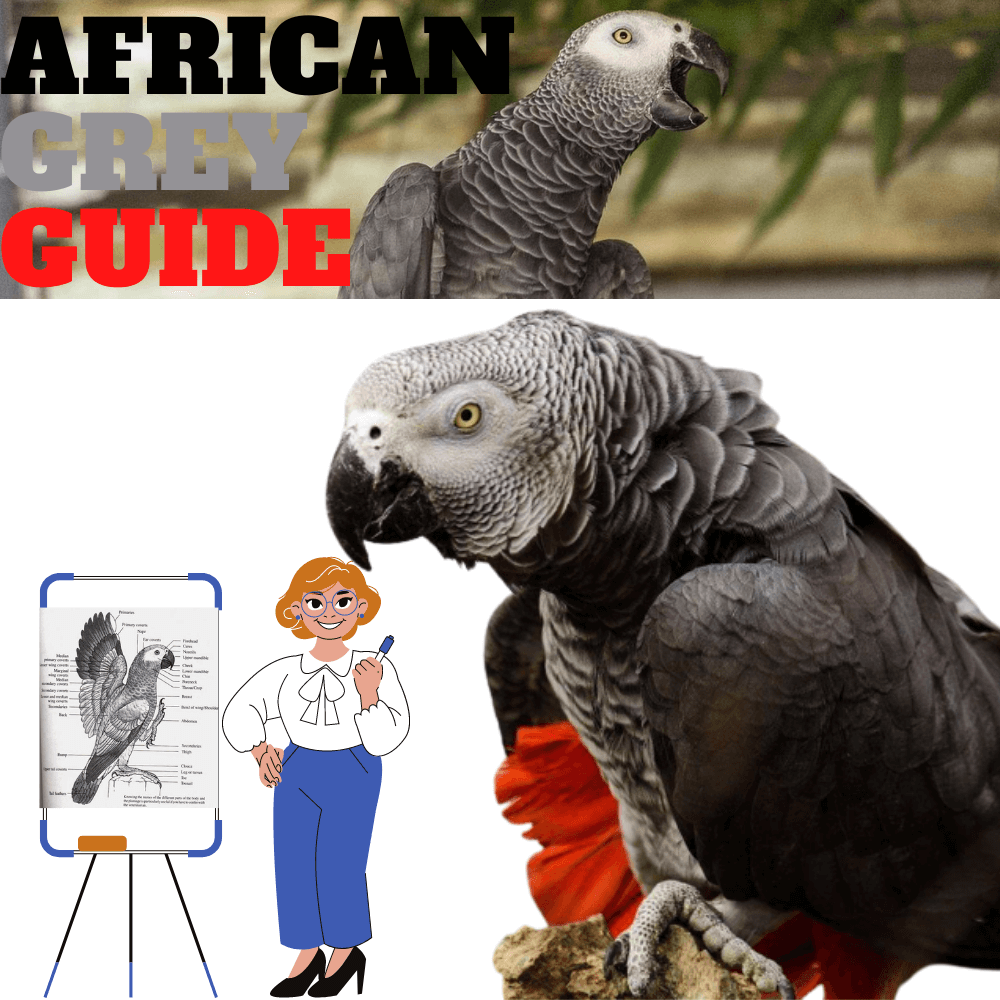
Region of Origin of the Grey Parrot
African Gray Parrots typically inhabit savannas, coastal mangroves, woodlands, and forest glade edges within their range in West and Central Africa.
Although the largest of the African Gray subspecies is referred to as the Congo African Gray. This bird actually has a much larger natural range in Africa. Particularly in the southeast of Côte d’Ivoire, Kenya, and Tanzania. The Timneh African Gray is found in a smaller region along the western edge of Côte d’Ivoire and in southern Guinea.
Difference between African Grey and Timneh
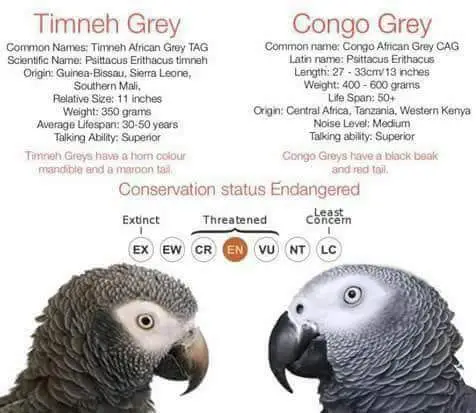
There are two distinct subspecies of the African Gray Parrot:

- the Congo African gray (Psittacus erithacus Erithacus), also called red-tailed gray
- Timneh’s African Gray (Psittacus erithacus Timneh)
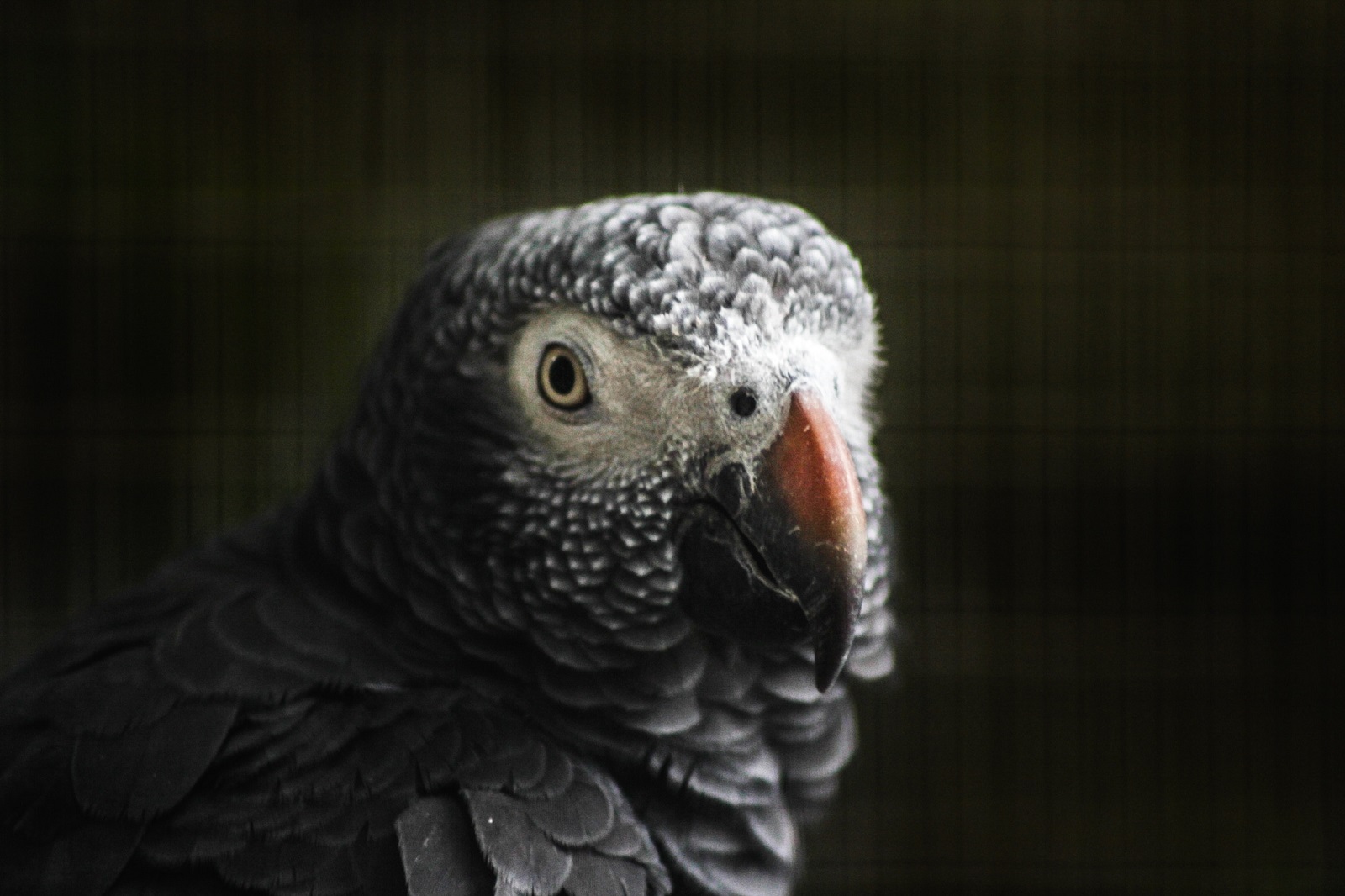
Often the great grays of the Congo were “Cameroonians” as they were once thought to be a subspecies of this region. But in reality, the larger birds were smuggled into Cameroon and had this country listed on their export documents.
These birds tend to come in different sizes and shades of gray because their natural habitat is so vast. However, the African Congo Gray, regardless of color or size, is always the same subspecies.
African Grey Care
African Grays need lots of toys that challenge their intelligence, such as foraging toys, puzzles, and educational colored hoops.
That’s why we offer you our collection of toys for your parrot.
Discover our collection of parrots toys by clicking on the image below.
Low-key beauty and a smart, thoughtful demeanor are the elements that keep this exotic bird at the peak of its popularity.
African Grey Parrot Origin
African Gray Parrots typically inhabit savannas, coastal mangroves, woodlands, and forest glade edges within their range in West and Central Africa.
Although the largest of the African Gray subspecies is referred to as the Congo African Gray. This bird actually has a much larger natural range in Africa. Particularly in the southeast of Côte d’Ivoire, Kenya, and Tanzania. The Timneh African Gray is found in a smaller region along the western edge of Côte d’Ivoire and in southern Guinea.
African Grey Behavior
Most birders believe that only an experienced bird watcher should have a gray. They are complex parrots, very sensitive, and more than demanding.
They are also charming and bright, but this combination of sensitivity and brain can lead to behavioral issues. They are creatures who love their habits. And so a little change in routine can make a sensitive gray miserable. They are particularly inclined to tear and chew their feathers.
African Parrot Complete Guide
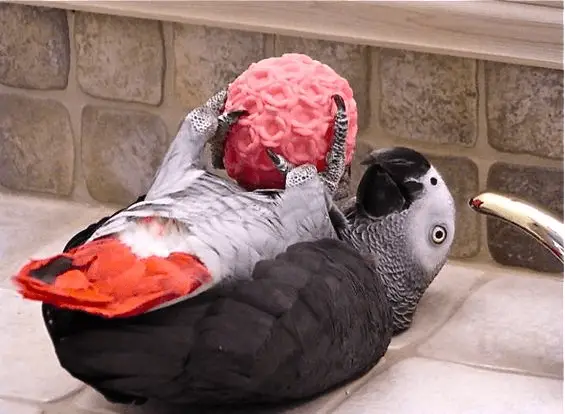
Anecdotally, African Gray Timneh has a tougher demeanor and may be best for households where a lot of people come and go. The African Congo gray on the other hand prefers a little less chaos.
African Grays are social parrots that need a lot of time to work, but they are not “cuddles”. They tolerate some head-scratching and a little hugging. But they don’t appreciate intense physical contact, although some people don’t hesitate to snuggle up a bit.
Each bird has unique tastes and preferences. A gray can also become a “one-person bird”, even if everyone in the household is around it from the start.
African Grey speech
African gray parrots are unquestionably among the most intelligent animals in the world.
Not only can they imitate human speech, but they can also learn to answer questions, express affection, and use things like deductive reasoning. Some studies claim that their intelligence is equivalent to that of a kindergarten child!
Much of the appeal of gray comes from its ability to speak. He is one of the best talkers of the parrot family. He is able to repeat the words and sentences after hearing them once or twice. This bird reaches its full speech capacity around the age of one year. Most people become able to imitate much sooner.
Not only will a gray develop an exceptional vocabulary, but research has also shown that this species can understand what it says.
The most famous of the GACs, Alex, and his colleague, Dr. Irene Pepperberg, may have been responsible for the popularity of this species, and certainly for its great notoriety. Alex and Dr. Pepperberg worked together for 30 years at Brandeis University until his unfortunate death in 2007, due to a catastrophic event associated with arteriosclerosis (“hardening of the arteries”).
During their three decades of research, Dr. Pepperberg taught Alex to recognize and identify objects, colors, and shapes. Alex could also understand the concepts of equal and different, of category, and could even count objects. Although Alex moved on to much more complex thought processes, including reading. His African Gray comrades Griffin and Arthur (aka “Wart”) continue to work with Dr. Pepperberg to try and get to the point Alex had reached and even go further.

But just because grays are intelligent and can choose to speak rather than scream doesn’t mean that it is wrong to believe that they are not loud.
They are not as loud or persistent as some South American species. But they learn household sounds and use them tirelessly to the chagrin of the owners.
Imagine the microwave beeping incessantly, or a cell phone ringing madly without being able to turn it off.
African Grey Parrot: Species in Decline (English)
SOURCE:Cornell Lab of Ornithology
How to get an African Grey Parrot
Adopting Congo African Grey Parrot is a decision to consider carefully. It will take a lot of commitment on your part. Notably, it can live between 30 and 80 years depending on the species. He will therefore become a member of your family.
Congo Gray is more popular among the two subspecies. The two birds, however, make very good companions.
African gray parrots are more often available in pet stores specializing in birds or from a bird breeder. African Grays are also sometimes available for adoption from organizations of rescue and adoption birds.
If you decide to adopt one of these magnificent birds, we offer you our parrot transport cages. Very useful for transporting your feathered friend safely. Whether it is for a trip to the vet or simply to bring back coconut from the pet store, it is an essential accessory to have.
Discover our collection of parrot transport cages by clicking on the image below.
Never buy imported wild birds. Breeding in captivity is more than enough to satisfy everyone. By buying directly imported parrots, you would contribute to the disappearance of certain species.
Before obtaining this magnificent bird, you are probably still wondering. That’s why we’ve answered the 44 most frequently asked questions below.
African Grey adoption
The 44 Frequently Asked Questions about African Gray Parrots
Where does the African grey parrot live?
The African gray parrot is found in equatorial Africa. Which means it is native to African countries that are near the equator.
These countries include Ghana, Gabon, Kenya, Uganda, Angola, Cameroon, Congo, and Côte d’Ivoire.
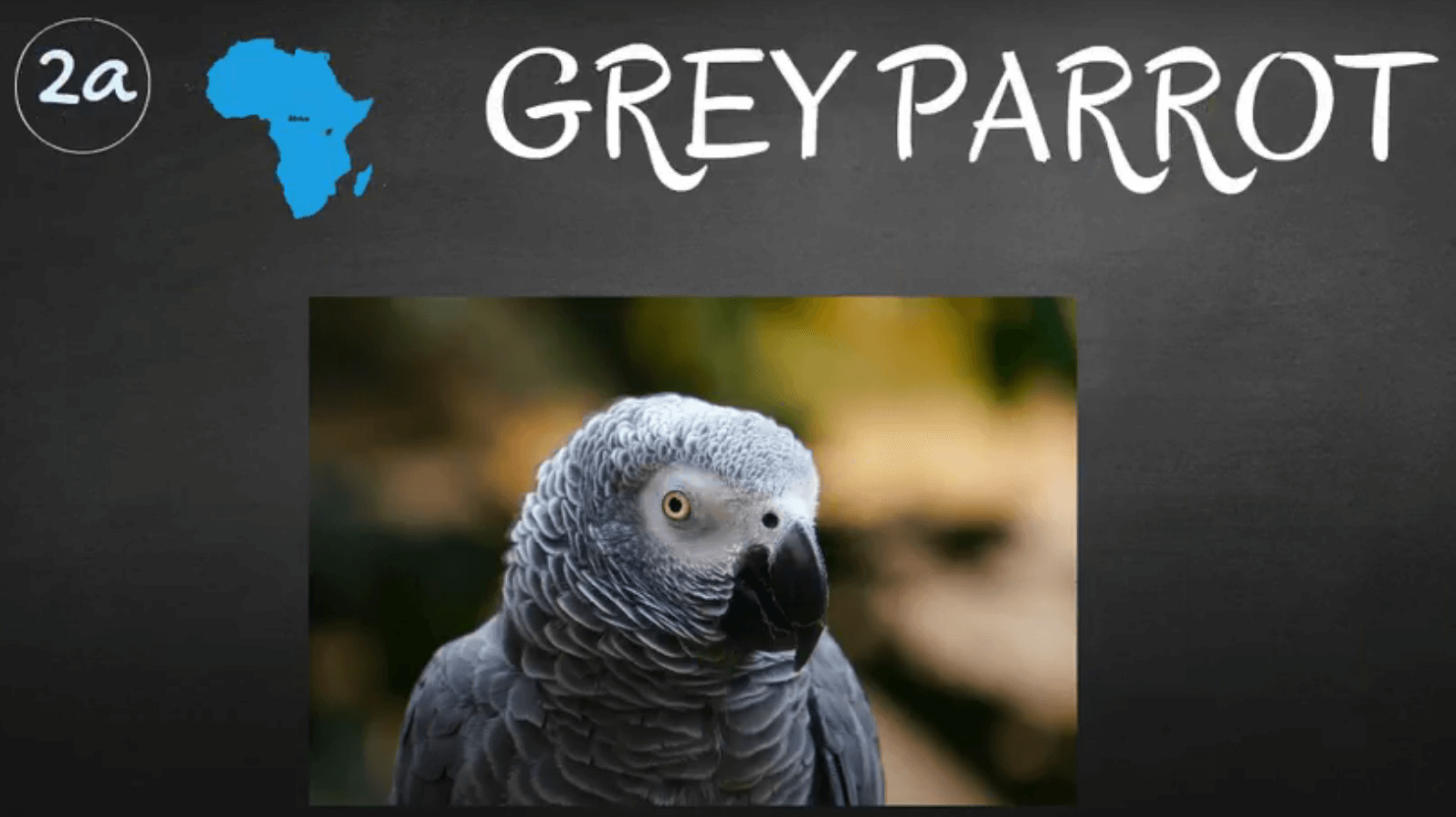

What are the other names of the African grey parrot?
It is sometimes called a “gray parrot”. But since this term can also apply to Timneh Gray Parrots, it is good to clarify which breed it is.
The African gray parrot is also known as the Congo gray parrot or Grey parrot.
By the way, the Timneh parrot is now classified as a separate species. It is also known as Timneh’s Gray Parrot or African Timneh’s Gray Parrot. It is sometimes referred to by the acronym GAT.
Revealing 10 Truths About Living With An African Grey Parrot
SOURCE:MARLENE MC’COHEN
What are the different types of African grey parrots?
There are two types of gray parrots in Africa:
- the African gray parrot (Psittacus erithacus)
- Timneh’s Gray Parrot (Psittacus timneh)
They are often confused with each other. In fact, they were classified as a single species until bird watchers separated them in 2012!
They have a lot of similarities in terms of diet, region, appearance, and breeding habits. So it’s easy to see why bird watchers saw double.
What is the difference between Timneh and Congo grey parrots?
They can look identical from afar. But when you pull out your binoculars and take a closer look, you notice some important differences between African Gray Parrots (Congo Gray) and Timneh Gray Parrots:
- The African Gray Parrot has a bright red tail, while the Timneh Gray Parrot has a darker, more brown tail.
- The African Gray Parrot is slightly larger. It reaches a size of 30 to 40 centimeters and weighs between 360 and 630 grams. While the Timneh gray parrot reaches a maximum size of 28 to 33 centimeters and weighs between 270 and 360 grams.
- The African gray parrot is native to Central Africa (Ghana, Kenya, Uganda, Congo) while the Timneh gray parrot is native to West Africa (Guinea, Mali, Sierra Lorne).
How smart is the African Grey Parrot?
They are said to have the cognitive abilities of a 3 to a 6-year-old human! One of the most remarkable things about African Gray Parrots is obviously their intelligence.
There is a whole list of awesome things African Grey a smart parrot can do. Their skills include:
- Imitate human speech
- Identify shapes and colors
- Learn number sequences
- Ask spontaneous questions
- Have full conversations with their owners
- They are even capable of things like deductive logic and probabilistic reasoning. They rank on par with dolphins and gorillas in terms of brainpower.
Can African Grey Parrots talk?
Yes. African Gray Parrots can both talk and sing.
They can be taught specific words and phrases for training purposes. Or they can just pick up sounds from their surroundings over time.
It is quite common for African Gray Parrots to surprise their owners with jingles they have heard on TV.
Can African Grey Parrots Understand What They Are Saying?
Some would say that parrots can only echo human sounds without realizing their meaning. But these people do not know parrots. This is especially true for the hyper-intelligent African gray parrot.
Everything suggests that they are able to learn, retain, analyze and share information when it concerns them.
African grey parrot facts: Here are some examples :
Talking to get home either: In Japan, a lost African gray parrot began to repeat its owner’s name and address when he was picked up and taken to a veterinary clinic. He knew he was lost, and he knew what he had to say to get home. Discover the full article
Understanding Words and Sounds: In Vienna, African Gray Parrots were able to determine which containers held food, even though they were only given auditory clues. They were able to process words and sounds and understand what they meant.
Asking for clarification of questions: A famous African gray parrot named Alex is said to have known over 100 words. He could identify numbers, shapes, colors, and objects. He would ask questions if he didn’t understand a task. According to the New York Times, he could also make requests like “want to come home” if he was transported to a place he didn’t like.
All of this suggests that African Gray Parrots understand the purpose of communication.
They may not be able to have an intellectual debate, but they think and speak differently from other animals. Imagine your dog looking at you one day and asking you, “But why should I go look?”
What is the habitat of the African grey parrot?
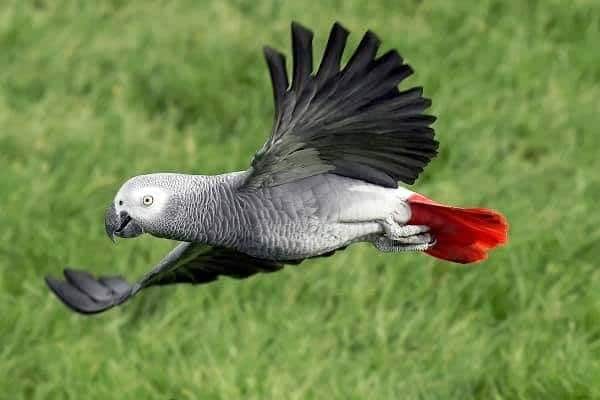
African Parrot Complete Guide
African Gray Parrots like dense, thick forests, but they have also been spotted at forest edges and in glades.
They usually cling to low canopies; the highest altitude ever recorded is 670 meters. They seem to have a preference for water. They often roost in trees that are above rivers and lakes.
Where do African grey parrots nest?
When it’s time to nest, African Gray Parrots move through tree holes. Cover can help protect their eggs from predators.
They usually jump into holes in unoccupied trees, but they are known to steal the nests of woodpeckers and other small birds.
Can African Grey Parrots fly?
Yes, African Gray Parrots are able to fly, but they don’t always do so as much as other birds.
For example, they use their beaks and claws to move around trees rather than flying from branch to branch.
They also love to perch on comfortable perches when in captivity. This is why we offer you our perches.
Discover our collection of parrot perches by clicking on the image below.
Why is the African grey parrot considered an “old world” parrot?
If you are new to birding, you may be wondering why some species are considered “Old World” parrots while others are called “New World” parrots.
Although they have some similarities, there are some key differences between the two:
- Old World parrots come from Africa and Asia, and New World parrots come from the Americas.
- Old World parrots know how to survive in hot, dry climates (Africa). New World parrots thrive in tropical rain forests (Amazonia).
- Old World parrots create more bird dust than New World ones, which could be because their species have adapted to different habitats. They are also more susceptible to fatal avian diseases such as pro-ventricular dilatation disease.
What does the African grey parrot look like?
African grey body and plumage: While the African Gray Parrot may look like a monochrome bird, its plumage features more nuance and subtlety than you might think!
It is not a solid gray. The feathers on its head and wings are a darker gray, while the feathers on its undercoat are a lighter, silvery gray. “The head ” feathers are streaked and tinged with white.
There are also a few other splashes of color. The African Gray has yellow eyes and a black bill. Its tail feathers are bright red. Mutations can occasionally make parrots red, blue, brown, or albino.
Learn More About: Why African Grey Parrot puff up
How big is an African grey parrot?
African Gray Parrots are typically around 35cm tall.
What is the weight of an African grey parrot?
African Gray Parrots can weigh between 270 and 630 grams but their average weight is just under 450 grams.
What is the wingspan of African grey parrots?
African gray parrots can spread their wings a distance of 45 to 50 cm depending on their size and weight.
Are African Grey Parrots affectionate or aggressive?
In general, African gray parrots are very friendly. In nature, they are gentle with each other. And as pets, they are generally friendly with their owners.
African Gray Parrots are very socially exotic birds that can live in groups of 50 or more. They have large, multigenerational broods where young and old mingle freely. Socialization and vocalization are a big part of their daily life. They even coordinate hunting parties when it’s time to eat.
Things can be a little different in captivity. As space is limited, African Gray Parrots can become territorial. They may not like being housed with other birds. Or they may become too defensive about “their” toys and snacks. They are also intelligent creatures who need a lot of attention and stimulation. If they don’t get one, they can face the attitude of their owners. A bored or frustrated bird may even come after you.
That said, you have nothing to fear from a happy and healthy African Gray Parrot. They are like any creature: They can cause problems when mistreated. But if you raise them correctly, they will make wonderful companions.
African Grey Complete Guide

How long do African grey parrots live?
African Grey Parrot lifespan: The grey parrot is around 40 to 60 years in captivity.
This number decreases considerably in nature; they only live 20 to 25 years in their natural habitat.
Why is the African grey parrot considered a “real” parrot?
The “real parrot” is a name given to a specific family of parrots.
They have a hooked beak, blunt tongue, long claws, and a similar diet of fruits and seeds. “Real” parrots include macaws, parakeets, caiques, and African gray parrots.
Is the African grey parrot always gray?
No. Despite its name, the African gray parrot is not always monochrome.
There are albino birds that are white or blue-white, and mutations can occur in nature. They give African gray parrots a mottled appearance with several different shades of red, brown, white, and silver-streaked all over their body.
There are also breeders who have done experiments to make African gray parrots redder. Some of them are born with all red or all pink plumage instead of gray. These specimens are generally sold at astronomical prices because they are so rare!
What are the predators of the African grey parrot?
African gray parrots are vulnerable to larger and stronger birds like raptors and vultures.
Their eggs are also attacked by monkeys. This is one of the reasons mothers guard their nests so fiercely.
Pythons also eat parrots and their eggs.
Grey parrots can also fall victim to terrestrial animals when they descend to the ground to hunt or forage for food. They don’t have specific enemies here, but they can be attacked by all kinds of foxes, jackals, snakes, and felines.
However, the greatest threat to African grey parrots is not an animal that flies in the sky or slides on the ground. They are human beings.
Is the African grey parrot endangered?
Yes.
The International Union for the Conservation of Nature (IUCN) has officially designated it as an endangered species. The Convention on International Trade in Endangered Species of Wild Fauna and Flora (CITES) has banned their international trade. Their populations are in decline in all the African countries they inhabit.
However, despite efforts to protect them, Congo African Grey is still in high demand. They are bred by exotic breeders or captured from the wild for sale or trade. According to a report, 20% of the world population of African gray parrots disappears each year from the birds market.
How many grey parrots are left in the world?
It is difficult to know how many Grey parrots are left. Some estimates say there could be less than a million, others put the number at a few million.
We just know they die quickly: According to one of the darkest statistics, Ghana has lost 99% of its African grey parrots since 1992.
What do African grey parrots eat?
African Grey Food: Congo African grey parrots are herbivorous and sometimes omnivorous. Their main diet consists of fruits, nuts, seeds, and flowers.
African Grey Guide
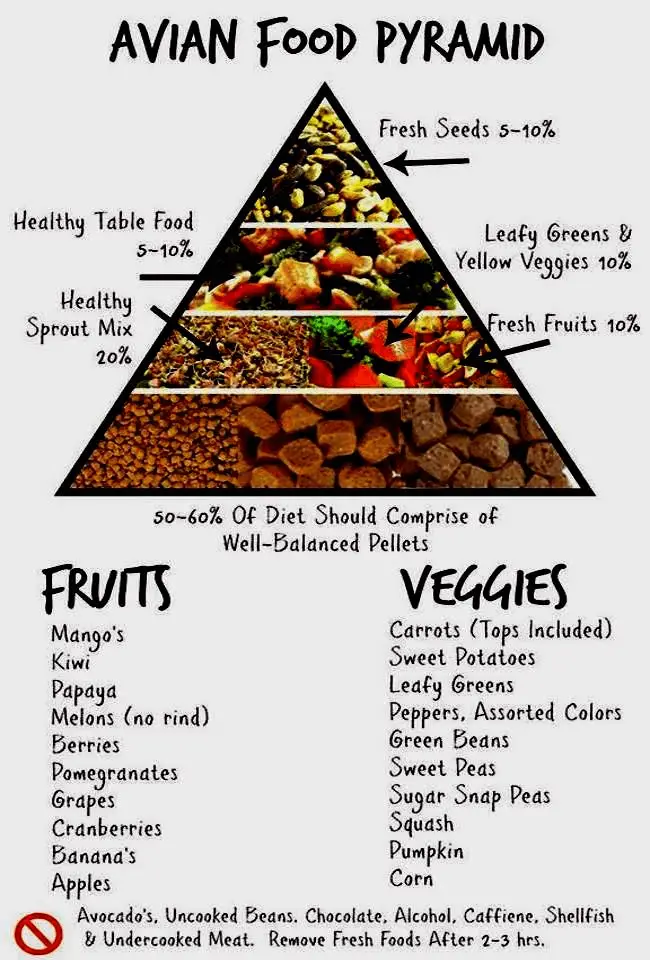
But they also munch on snails and small insects when they get the chance.
In captivity, they can survive on bird feed, but their diet should be supplemented with fruits and vegetables. They eat apples, bananas, cucumbers, peas, potatoes, green beans, and fresh collard greens.
How do African grey parrots hunt?
Although most of their diet comes from foraging rather than hunting. African Parrot grey parrots are not afraid to skewer a juicy insect when it comes in their way.
However, they don’t eat on their own. Grey Parrots are very social animals that hunt in groups. They have a whole system for finding their food in groups. They begin by congregating in a single tree with parrots crammed into each branch. Then, when their number is sufficient, they take turns descending to the ground and looking for food.
The whole herd is never on the ground at the same time. Some of them are always on the lookout for predators, and even hunters remain vigilant in the face of danger. It is very easy to disperse a group of Gray Parrots as they will fly away at the slightest noise or movement.
What is the Latin name for African grey parrots?
The scientific name for the African parrot is Psittacus erithacus. Here’s a look at their entire lineage:
- Class: Aves (birds)
- Order: Psittaciformes (parrots)
- The family: Psittacidae (“real” parrots)
- Subfamily: Psittacinae (Old World parrots)
- Genus: Psittacus (African parrots)
- Species: Psittacus erithacus
Do African Grey Parrots Mate for Life?
It is not known if African Parrots mate for life. But they form monogamous pairs that stay together for several mating seasons.
They court each other before accepting each other and laying eggs together. Both parents feed, house, care for, care for and socialize their babies. It’s very different from other bird species where the mother does everything and the father doesn’t even stay for the hatching.
With Parrot African Grey, both parents are equal partners in mating and raising children.
At what age do African Grey Parrots lay eggs?
African grey parrots reach sexual maturity between 3 and 5 years old.
Both males and females mature at the same rate.

African Parrot Complete Guide
How often do African Grey Parrots lay eggs?
Parrot African Grey lays eggs 1-2 times a year.
We don’t know much about their breeding season. But it seems to correspond to dry weather. So African greys can lay eggs at different times in different countries.
How many eggs can the African Grey Parrot lay?
The eggs of an African parrot are white and tiny.
The mother usually lays 3 to 5 at a time. The young weigh only 12 to 14 grams at birth. They will be red, bald, wrinkled, and hairless. They will develop a layer of soft, fluffy down before their first feathers start to grow.
How do African grey parrots take care of their young?
It starts with the incubation of their eggs. It takes about 30 days for babies to hatch. The female hides in her hole in a tree and sits on top of them all the time. She will not budge from her post. The male will take care of the foraging and return to feed and keep her while she protects the eggs, which are very important to them.
Once the babies are born, the mother and father will be active parents together. Their main priority will be to protect the small, vulnerable, from predation. But they will also have to teach them to eat, to fly, to forage, and to vocalize.
Young Congo Parrots leave the nest around 12 weeks old, but they won’t get far.
They will stay with their parents for many months before becoming fully independent. Everyone must learn herd dynamics (including complex hunting formations) and the lessons take time.
Learn More About: How to breed a young grey parrot
What cries do African grey parrots make?
In the wild, Parrot African Grey Parrot has a complex series of vocalizations. These include alarm calls, contact calls, distress, and hunt calls, in addition to daily chatter and preening when large herds are gathered.
Research suggests they have excellent hearing and are able to distinguish very minor note changes. They might even be able to recognize specific calls from their companions and children.
Are African Grey Parrots noisy?
They have absolutely no place in a library! Grey Parrots are songbirds who love to talk and sing.
Although they are not consistently loud, they have no sense of volume regulation. They only stop singing and chatting when they feel like it. As charming as they can be, you don’t want to bring home a Grey African Parrot if you value peace and quiet.
Are African grey parrots disease carriers?
Parrot Grey can carry many worms, parasites, diseases, and infections. They can be surprisingly delicate birds. Most of these diseases are only dangerous for other members of the avian family. But one of them can be transmitted to humans: psittacosis.
Also known as “parrot fever”, psittacosis is characterized by rashes, headaches, high temperatures, joint pain, and nosebleeds. It is often confused with typhoid fever or meningitis. Severe cases may require hospitalization.
To avoid contracting psittacosis, always be sure to wash your hands after playing with your parrot. Keep their cages clean and use gloves to handle their droppings. Stay alert for their general health. If you notice any suspicious symptoms in your parrot, don’t hesitate to contact your veterinarian and have them checked.
Do African grey parrots have a special meaning in African culture?
Grey Parrot is very popular among the Yoruba of Nigeria. At their annual Gelede festival, the gray face and blood-red tail feathers are painted on all manner of costumes and masks.
Congo Grey Parrot is also linked to many spy and sentry myths since they are known for their vocalizations.
Where can I see the African grey parrot?
The Congo African Parrot is found in a few zoos. This is not a common characteristic as it is very rare and elusive in nature. If you want to see an African Gray Parrot in the flesh, you will likely need to hire a breeder.
Are grey parrots good pets?
It depends on your definition of “good”. Congo African Grey Parrot are intelligent creatures that can become fun, active, and playful pets. But they also require a lot of time and attention. You can’t just put them in a cage and forget about them. They won’t let you do it!
For example, Parrot African Grey gets bored easily. If you don’t stimulate them enough, they may start to annoy you by chatting and moving around. They are also known to bring out their boredom on other birds, so they can become a bit of a problem child for you if you have a whole menagerie.
If you are considering Adopt African grey parrot, make sure that you are ready to make a full-time and long-term commitment. He can be a lifelong companion, but you have to be prepared to invest yourself.
It is a good idea to educate yourself on the care of a grey parrot before purchasing one. It’s best to know what that entails before committing to owning it.
Is it legal to have an African Grey Parrot as a pet?
You need to check the local law.
Where To Buy A Parrot African Grey, While it is illegal to buy or sell wild-caught African Parrots, there are loopholes for captive-bred birds.
This is why you might see Gray Parrots in pet stores, even though they are considered an endangered species.
Note: Always check with your breeder/pet store to confirm that the parrot you are considering purchasing has been captive-bred. African parrots captured in the wild are endangered and it is illegal to buy or sell them.
African Parrot Guide
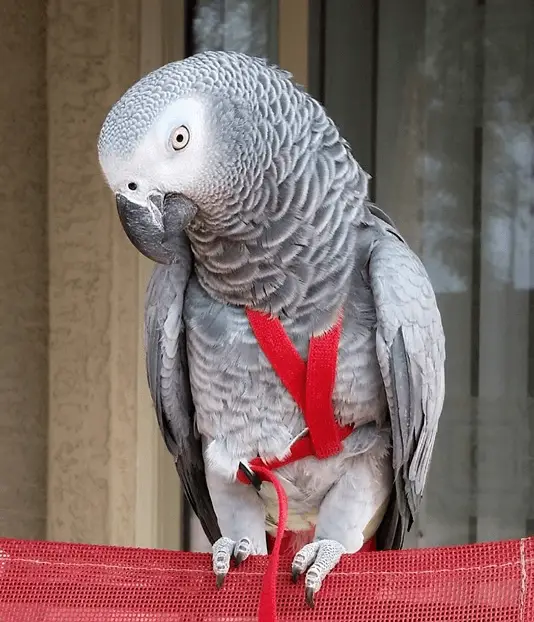
How much do African grey parrots cost?
African Grey Parrot Price: the prices for Grey Parrot start at 1600$ and can reach 4000$ or more!
Young birds are more expensive than older ones, and females are more valuable than males.
How do I teach my African Grey Parrot to speak?
Most parrots are smart enough to start picking up human speech even if they are not trained to do so.
If you want to teach them something specific, here are some tips:
- Start small. Don’t expect them to recite Hamlet straight away! Teach them simple phrases like “hello” and “goodbye,” and once they’re comfortable with their new vocabulary, start incorporating the words into a back-and-forth dialogue.
- Repeat them. This is how parrots learn to recite full commercials. They hear them over and over again.
- Use a reward system. Give your parrot a reward every time they imitate you. Positive reinforcement is a long-standing tradition among pet owners.
- Don’t expect perfection. Some parrots are better “talkers” than others, and no practice can change that. For example, some may be able to gossip like a schoolgirl, while others may only shout a limited number of syllables. Love your African Grey Parrot for the parrot it is, not the parrot you want it to be!
Can African grey parrots understand humans?
Yes. As a species, the parrots are known for their ability to understand and copy human speech.
African Gray Parrots are some of the smartest in their entire family, so you should have no problem teaching them how to chat with you.
Do African Grey Parrots Bite?
Does African Grey Parrot Biting ? Yes. When bored, stressed, frustrated or sick, African Grey can become stubborn.
This is one of a series of behaviors that owners of Congo Parrot have to deal with. These feather dusters can engage in all kinds of activities, from grinding fingernails to pulling feathers when they behave badly. They have the same cognitive abilities as a 3-6-year-old child, so you should treat them like misbehaving toddlers.
However, it is not always a behavioral problem. It can be a sign of affection. But unless you like bleeding from your fingers, it’s probably not a habit you should encourage.
What type of cage do you need for an African Grey Parrot?
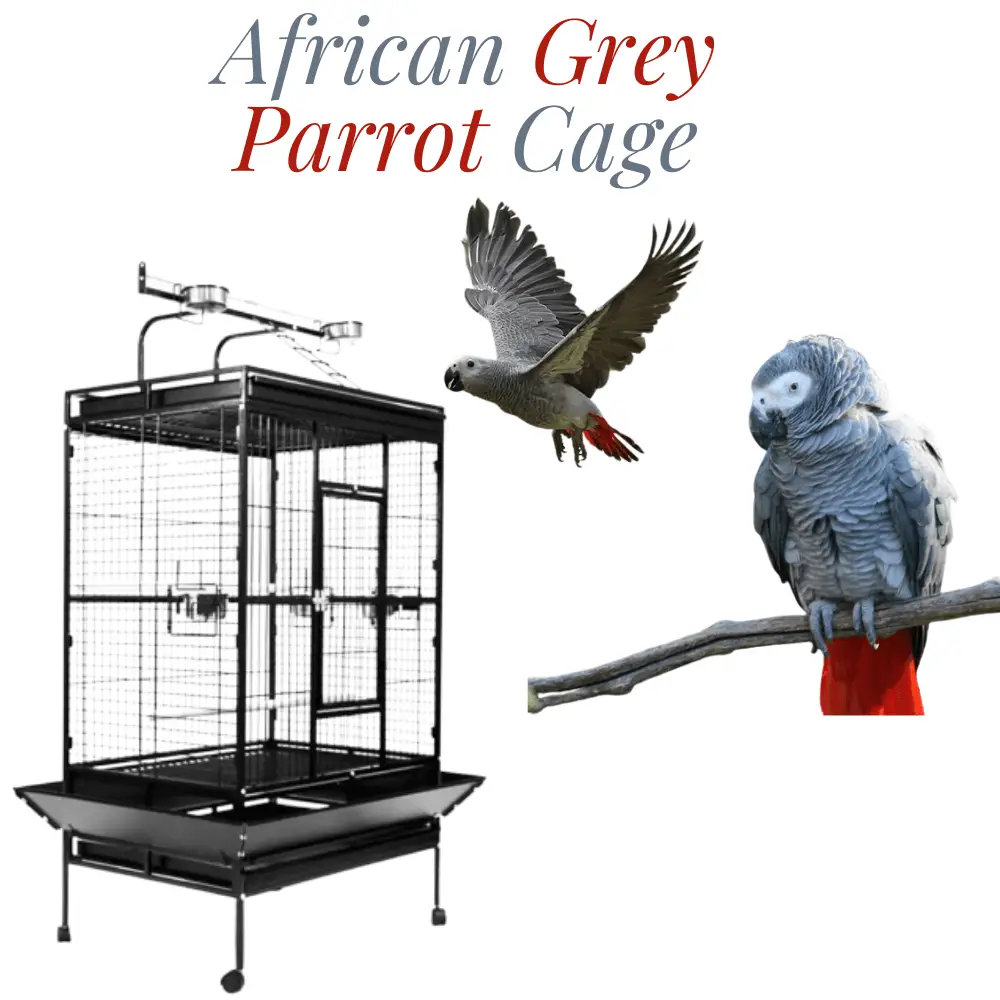
There are several things that go into buying a good African Grey Parrot cage:
- Size: African grey parrots need room to spread their wings. The recommended cage size is therefore at least 1.5 to 2 meters on each side. It should also be noted that the width is just as important as the height. So rather than investing in a tall, narrow cage, try to find something with more even measurements.
- Hiding places: African parrots have a strong hunting instinct and their natural habitat is a thick forest canopy with lots of leaves and holes in the trees. They will not be comfortable in a large, open cage where they are constantly exposed to light. Give them places where they can retreat.
- Perches: African Parrot Grey like to roost, but they are not always stable. They need large, sturdy surfaces that they can hold onto to avoid falling and getting injured.
Is African grey parrot messy?
It’s not an answer owner wants to hear, but yes African Grey Parrots can be messy!
In addition to their cheerful relationship with poop, they also enjoy tearing up papers, toys, fabrics, and antlers as part of their game. Don’t expect your Parrot African Grey to be a clean bird and well ordered.
Which parrot is the smartest?
This distinction obviously goes to the African grey parrot. They are considered to be the smartest parrots on the planet.























